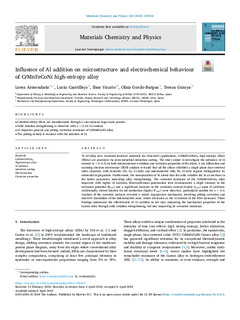Título
Influence of Al addition on microstructure and electrochemical behaviour of CrMnFeCoNi high-entropy alloyAutor-a
Grupo de investigación
Sistemas electrónicos de potencia aplicados al control de la energía eléctricaOtras instituciones
Universidad del País Vasco/Euskal Herriko Unibertsitatea (UPV/EHU)Tecnalia
Versión
Version publicada
Derechos
© 2024 The AuthorsAcceso
Acceso abiertoVersión del editor
https://doi.org/10.1016/j.matchemphys.2024.129316Publicado en
Materials Chemistry and Physics Vol. 318. N. art. 129316. 1 May, 2024Editor
ElsevierPalabras clave
CrMnFeCoNiAlx
High-entropy alloy
Al addition
Induction casting ... [+]
High-entropy alloy
Al addition
Induction casting ... [+]
CrMnFeCoNiAlx
High-entropy alloy
Al addition
Induction casting
Microstructure
Corrosion properties [-]
High-entropy alloy
Al addition
Induction casting
Microstructure
Corrosion properties [-]
Resumen
To develop new corrosion-resistant materials for structural applications, CrMnFeCoNiAlx high-entropy alloys (HEAs) are produced via semi-industrial induction casting. The study aimed to investigate th ... [+]
To develop new corrosion-resistant materials for structural applications, CrMnFeCoNiAlx high-entropy alloys (HEAs) are produced via semi-industrial induction casting. The study aimed to investigate the influence of Al content (x = 0–0.3) on both microstructure evolution and corrosion properties of the alloys. X-ray diffraction and scanning electron microscopy (SEM) analysis revealed that all the alloys exhibited a single-phase face-centered cubic structure, with dendritic (Fe, Co, Cr-rich) and interdendritic (Mn, Ni, Al-rich) regions distinguished by elemental segregations. Furthermore, the incorporation of Al atoms into the solid solution led to an increase in the lattice parameter, indicating alloy strengthening. The corrosion resistance of the CrMnFeCoNiAlx alloy improved with higher Al addition. Electrochemical polarisation tests demonstrated a slight increase in the corrosion potential (Ecorr) and a significant decrease in the corrosion current density (icorr) upon Al addition. Additionally, slower kinetics for pit nucleation (higher E'corr) were observed, particularly notable for x = 0.3. Analysis of the corroded surfaces revealed a mixed degradation mechanism, involving pitting corrosion and selective dissolution of the interdendritic zone, which decreased as the Al content of the HEA increased. These findings underscore the effectiveness of Al addition in not only enhancing the mechanical properties of the Cantor alloy through solid solution strengthening, but also improving its corrosion resistance. [-]
Colecciones
- Artículos - Ingeniería [753]
El ítem tiene asociados los siguientes ficheros de licencia:






















